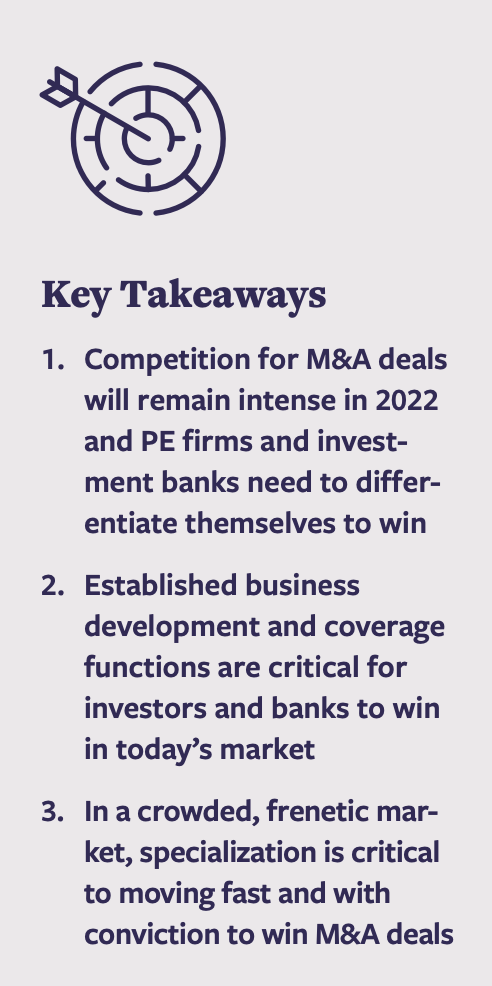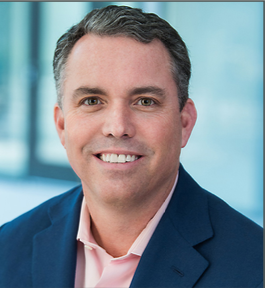Changing Dynamics in the Dealmaking Process
Citizens examines how PE firms and investment bankers can differentiate themselves in a competitive market

After a slowdown in 2020, there was a full sprint to complete M&A deals by the end of 2021, a surge that’s expected to continue through 2022. A primary driver of this deal flow in the middle market has been private equity firms, which are playing a bigger and bigger role as both buyers and sellers.
PE shops are proliferating and continue to raise enormous amounts of capital that they must deploy, and they also need to exit their portfolio companies to generate returns for their investors. The universe of potential buyers for a traditional middle-market deal has drastically expanded over the past five years.
This report originally appeared in the Business Development Professionals to Watch special report. Read the full story in the archive.
In short, competition is intense, and with interest rates still low, deal valuations are at record highs. It’s become a very fluid, crowded market. The number of middle-market deals rose 27% from 2,621 in 2020 to 3,338 in 2021, according to Pitchbook. More remarkable is that about 72% of those deals were closed by PE as opposed to strategic buyers, and the number of private equity deals has almost tripled in 10 years, from 860 to 2,406.
Build Relationships to See Deals
The vast majority of financial sponsors now have dedicated business development professionals and, similarly, nearly every investment bank has institutionalized the coverage of PE firms. These roles have become more defined over the past five years and more critical to keeping the market running efficiently.
More specifically, business development professionals at PE firms focus on creating and maintaining strong relationships with investment banks and key industry players to ensure their firm is seeing all the investment opportunities that fit its mandate, and that the firm is well-positioned to win deals. Meanwhile, coverage professionals at investment banks focus on this relationship-building to ensure their firms’ mandates get the appropriate attention from the decision-makers at the likely buyers, with the ultimate goal of generating more business with their covered firms.
Related content: Lending Through the Pandemic: The Value of Deep Relationships
Specialize in Sectors to Win Deals

Another fundamental shift in the M&A market, which amplifies the importance of good business development, is the amount of sector specialization that has emerged over the past few years. Many PE firms have narrowed their focus to gain a competitive advantage. For example, while they are still broadly targeting business services deals, a PE firm today might hone in on soft facility services as their ideal investment opportunity. Or, instead of looking broadly at basic industrials, a firm might focus on industrial automation. Experts are more likely to win deals in their chosen sector because they can more quickly get up to speed on the opportunity and value that transaction with more conviction. PE firms increasingly believe that the sector intelligence derived from specialization enables them to generate additional value during their hold period.
As a result of this specialization and the emergence of institutionalized coverage and the business development function, the sell-side process has become more efficient. Some examples of this efficiency include:
-
- Buyers lists that are more targeted thanks to greater specialization
- Higher touch, senior banker-led processes that are imperative to stand out and garner attention from PE
- Earlier and expanded access to management during the marketing process
- More preemptive and third-party work completed by buyers and sellers to shorten diligence timelines
- Shorter exclusivity periods and fewer financing contingencies
Looking Forward
Given these dynamics, what does the immediate future hold for middle-market dealmaking? Interest rates are set to rise this year, inflation is at a 40-year high and geopolitical issues are adding a troubling level of uncertainty. That would seem to lay the groundwork for a deal slowdown. Yet PE firms still have huge amounts of dry powder that they must deploy. By mid-2021, the sector had amassed a record $3.3 trillion of unspent capital, according to Bloomberg, giving it significant firepower for fresh acquisitions. There is also an enormous inventory of PE portfolio companies that must be sold to satisfy investors. That will likely keep the deal spigot on.
We expect that deal volume in 2022 will be roughly on par with 2021, and that the rules of engagement that have emerged over the past five years will become more entrenched. To compete in this crowded, frenetic environment, companies need to specialize in sectors to zero in on the most enticing deals. With this expertise, companies can get up to speed on opportunities quickly, bid with conviction and generate additional value during the hold period. Equally important to specialization will be building and maintaining relationships. Strong relationships will help ensure that the firm continues to see all the investment opportunities that fit its mandate and is always well-positioned to win deals.
Related content: Private Equity Takes a More Targeted Approach
Jim Childs is head of Citizens M&A Advisory. He has extensive experience in advising middle-market companies in mergers and acquisitions as well as capital raising. Childs has led over 75 transactions in his career.



